- A lack of occupational health and safety standards, training or personal protection equipment provided.
- Limited or no access to treatment, emergency services and compensation when a worker is injured or killed on the job.
- Less than minimum wages.
- Use of child labor.
- Extensive working hours with no right to overtime, sick or annual leave.
- Lack of job security: no work no pay.
No right to join or form a trade union.
In the majority of the shipyards, workers are being deprived of their rights. They work under risky conditions but have no access to safety equipment, job security or a living wage.
OHS, accidents and diseases
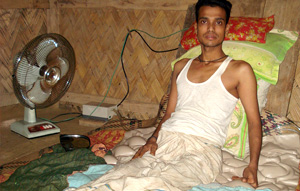 Over the last twenty years more than 400 workers have been killed and 6000 seriously injured according to the Bangladeshi media. These are the ones that have been reported. The explosion of the Iranian tanker TT Dena on 31st May 2000 alone is said to have caused 50 deaths. To this toll, the thousands of cases of irreversible diseases which have occurred and will continue to occur due to the toxic materials that are handled and inhaled without any precautions or protective gear need to be considered.
Over the last twenty years more than 400 workers have been killed and 6000 seriously injured according to the Bangladeshi media. These are the ones that have been reported. The explosion of the Iranian tanker TT Dena on 31st May 2000 alone is said to have caused 50 deaths. To this toll, the thousands of cases of irreversible diseases which have occurred and will continue to occur due to the toxic materials that are handled and inhaled without any precautions or protective gear need to be considered.
On average, one worker dies in the yards a week and everyday a worker is injured (End of Life Ships: the Human Cost of Breaking Ships). It seems like nobody really cares: ship breaking workers are easily replaceable to the yard owners: if one is lost they know another 10 is waiting to replace him due to the lack of work. The Government collects the taxes and turns a blind eye.
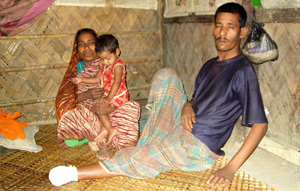 Ship breaking carries a very real risk to life. By any standards, the demolition of ships is a dirty and dangerous occupation. The hazards linked to ship breaking broadly fall into two categories: intoxication by dangerous substances and accidents on the plots. Explosions of leftover gas and fumes in the tanks are the prime cause of accidents in the yards. Another major cause of accidents is workers falling from the ships (which are up to 70 m high) as they are working with no safety harness. Other sources of accidents include workers being crushed by falling steel beams and plates and electric shocks.
Ship breaking carries a very real risk to life. By any standards, the demolition of ships is a dirty and dangerous occupation. The hazards linked to ship breaking broadly fall into two categories: intoxication by dangerous substances and accidents on the plots. Explosions of leftover gas and fumes in the tanks are the prime cause of accidents in the yards. Another major cause of accidents is workers falling from the ships (which are up to 70 m high) as they are working with no safety harness. Other sources of accidents include workers being crushed by falling steel beams and plates and electric shocks.
Workers are not aware of hazards to which they are exposed. The overwhelming majority of workers wear no protective gear and many of them work barefoot. There is hardly any testing system for the use of cranes, lifting machinery or a motorized pulley. The yards re-use ropes and chains recovered from the broken ships without testing and examining their strength. There is no marking system of loading capacity of the chains of cranes and other lifting machineries.
Consequently, workers suffer from lung problems which cause temporary loss of working capacity. The hatches and pockets of vessel may contain explosive or inflammable gases. The cutters, if they understand from experience, drill small holes in order to release gases or fumes. This still however, often cause severe explosions.
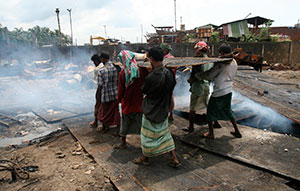 Gas cutters and their helpers, cut steel plates almost around the clock without eye protection. This leaves their eyes vulnerable to effects of welding. They do not wear a uniform and most don’t have access to gloves and boots. Those that are ‘unskilled’ carry truckable pieces of iron sheets on their shoulders and there are no weight limits to the sheets they carry. Usually, these workers carry weights far above the limit prescribed in the Factories Act and Factories Rules.
Gas cutters and their helpers, cut steel plates almost around the clock without eye protection. This leaves their eyes vulnerable to effects of welding. They do not wear a uniform and most don’t have access to gloves and boots. Those that are ‘unskilled’ carry truckable pieces of iron sheets on their shoulders and there are no weight limits to the sheets they carry. Usually, these workers carry weights far above the limit prescribed in the Factories Act and Factories Rules.
The beaches are strewn with chemicals and toxic substances, small pieces of pointed and sharp iron splinters causing injuries. Workers enter into the areas without wearing or using any protective equipment. Occupational health and safety is clearly not a priority for the owners and as for the workers their desperate need to find employment to support their families means that their livelihoods take precedence over their lives.
Treatment and compensation
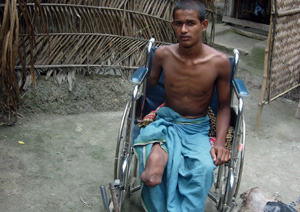 When there is an injury some immediate treatment may be given but there is no long term treatment for those who have a long term or permanent injury. In terms of compensation, only a nominal amount of compensation given and often only when there is public pressure.
When there is an injury some immediate treatment may be given but there is no long term treatment for those who have a long term or permanent injury. In terms of compensation, only a nominal amount of compensation given and often only when there is public pressure.
When a worker becomes disabled by a major accident, he gets a maximum of 10 to 15 thousand taka (1 USD=71 taka) and forced back to his home district. In most cases a worker will only get transportation costs to go back to their home district.
When a worker killed in an accident, the contractor, who is responsible for the workers, will only pay the Injured child worker in wheel chaircosts of sending the body back to the victim’s family and arranging for their burial.
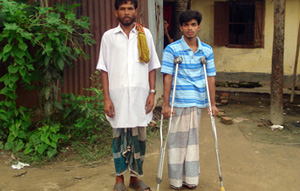 In the case of local workers from the area, if they die on the job, their family receives more than 50,000 taka as compensation. This is mainly due to the fact that the yard owners and contractors cannot avoid the locals who yield some power and pressure them. Prior to 2006, the labor laws in Bangladesh had a lot of limitations. The Workers Compensation Act 1965, only 30,000 taka was proposed for a 100% disable worker and 21,000 taka for dead worker’s family. The recently passed Labor Law Act 2006 now stipulates that a 100% disabled worker will receive 100,000 taka and a deceased worker’s family will receive xxx taka.
In the case of local workers from the area, if they die on the job, their family receives more than 50,000 taka as compensation. This is mainly due to the fact that the yard owners and contractors cannot avoid the locals who yield some power and pressure them. Prior to 2006, the labor laws in Bangladesh had a lot of limitations. The Workers Compensation Act 1965, only 30,000 taka was proposed for a 100% disable worker and 21,000 taka for dead worker’s family. The recently passed Labor Law Act 2006 now stipulates that a 100% disabled worker will receive 100,000 taka and a deceased worker’s family will receive xxx taka.
Child labor
In Bangladesh, most poor families are more or less dependent on the children’s income for survival. The Bangladesh Shishu Adhikar Forum (BASF) has identified 430 risky jobs. Within these 67 professions are classified as very much risky and 11 are classified as dangerous. Shipbreaking is falls in the latter.
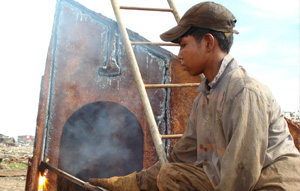 YPSA’s baseline survey in 2003, 10.94% of the labor force is made up with children (age up to 18). Most of the children come from the northern regions of Bangladesh. It was noticed that shipbreaking contractors prefer to recruit children as they are less expensive than their adult counterparts.
YPSA’s baseline survey in 2003, 10.94% of the labor force is made up with children (age up to 18). Most of the children come from the northern regions of Bangladesh. It was noticed that shipbreaking contractors prefer to recruit children as they are less expensive than their adult counterparts.
The children work mainly as gas cutters assistants and move small iron pieces from one place to another. They either work in the yard from sunrise to sunset or do the night shift. On average they receive 50-60 taka a day for their efforts. There are no educational or recreational facilities.
Bangladesh has adopted the United Nation’s Convention on the Rights of the Child (UNCRC) in 1990. Bangladesh has a number of laws for the protection of children. For instance articles 14 and 15 of the Constitution, a child has the right to social security rights. Act no. 28, the state has been given power to impose special ordinance for serving the child’s interest. Act no. 34 prohibits the coercion of children into doing hard labor. The Children Act (1974) has banned the use of vulnerable child labor yet we still see children working in the shipbreaking yards in Bangladesh.
Other conditions
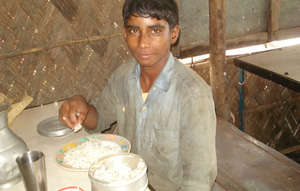 In addition to the health and safety issues, workers work extremely long hours for little pay (please see table one for details). For all this they have no entitlement to sick leave, annual leave or overtime and as they are hired on a hourly basis, they have no idea whether they’ll have work the following day. Add to this the number of people seeking work the contractors and employers have a huge advantage over the workers. This has also made it difficult for them to organize as they are threatened with their livelihoods if they join or try and form a union to bargain for better conditions. It is no hollow threat either. With such a power imbalance, the Government has to develop a policies and legislation to ensure their rights.
In addition to the health and safety issues, workers work extremely long hours for little pay (please see table one for details). For all this they have no entitlement to sick leave, annual leave or overtime and as they are hired on a hourly basis, they have no idea whether they’ll have work the following day. Add to this the number of people seeking work the contractors and employers have a huge advantage over the workers. This has also made it difficult for them to organize as they are threatened with their livelihoods if they join or try and form a union to bargain for better conditions. It is no hollow threat either. With such a power imbalance, the Government has to develop a policies and legislation to ensure their rights.
Click here for PDF version of Base line survey (2003) which shows the condition of ship breaking workers in Bangladesh.
